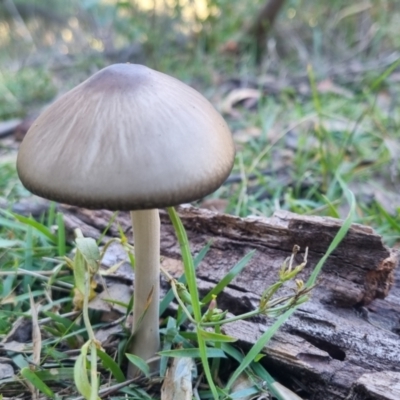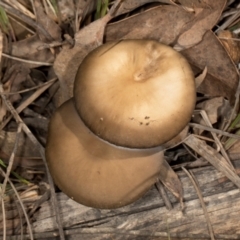Oudemansiella gigaspora group (Rooting Shank)
The fruit bodies of this group of species are mushrooms. The caps (up to 8 cm in diameter, but often only about half that) are usually some shade of grey-brown to olive-brown; flat or with a shallow curvature and often with a slight central bump; smooth; tacky to slimy in moist conditions. They may become wrinkled in dry conditions. The gills are white. The stems are very long in relation to cap diameter and may approach 20 cm in length and about a centimetre in diameter, white in the upper half and grey-brown lower down. Mostly the mushrooms are solitary but sometimes you will see small groups and while they almost always appear to be growing in soil, they arise from buried wood.
At one stage the name Oudemansiella radicata was applied to Australian specimens but (1) this was found to be inappropriate and (2) specimens named to that species were found to represent several macroscopically similar species. Australian specimens were shunted into the genus Xerula and then back to Oudemansiella. Given the macroscopic similarity of these Oudemansiella species, for the purposes of Canberra Nature Map I lump them all together as Oudemansiella gigaspora group. At least two species of this group are known to occur in the ACT: Oudemansiella gigaspora and Oudemansiella variabilis.
If you dig carefully you may be able to follow the stem of one of these mushrooms down to the wood, often many centimetres below the soil surface. The below-ground part of the stem is superficially root-like, hence the species epithet radicata (derived from the Latin word for root) and the colloquial name of Rooting shank.
Oudemansiella gigaspora group is listed in the following regions:
Canberra & Southern Tablelands | South Coast
1 2
Species information
- Oudemansiella gigaspora group Scientific name
- Rooting Shank Common name
- Not Sensitive
- Local native
- Non-invasive or negligible
- Up to 1451m Recorded at altitude
- Machine learning
-
In flower
- External link More information
-
Synonyms
Oudmansiella radicata, Xerula radicata, X. radicata var. australis Oudemansiella 'radicata group'
Location information
-
Maps
ANBG ANBG South Annex ANU Garran Precinct Aranda Bushland Australian National University Bicentennial Park Black Mountain Boro Bruce Ridge Bruce Ridge to Gossan Hill Bungonia State Conservation Area Cooma North Ridge Reserve Crace Grasslands Federal Golf Course Flea Bog Flat, Bruce Gang Gang at Yass River Goulburn Mulwaree Council Gungaderra Grasslands Hall Cemetery Hughes Grassy Woodland Isaacs Ridge Isaacs Ridge and Nearby Lake Ginninderra Lower Cotter Catchment Mongarlowe River Mount Ainslie Mount Jerrabomberra Mount Jerrabomberra QP Mount Majura Mount Painter Mount Taylor MTR591 at Gundaroo Namadgi National Park Percival Hill Pomaderris Nature Reserve Red Hill Nature Reserve Red Hill to Yarralumla Creek Sullivans Creek, Acton The Pinnacle Tidbinbilla Nature Reserve Umbagong District Park Wanniassa Hill Woodstock Nature Reserve -
Places
Cook, ACT O'Connor, ACT Pialligo, ACT Uriarra Village, ACT












































































































































































































